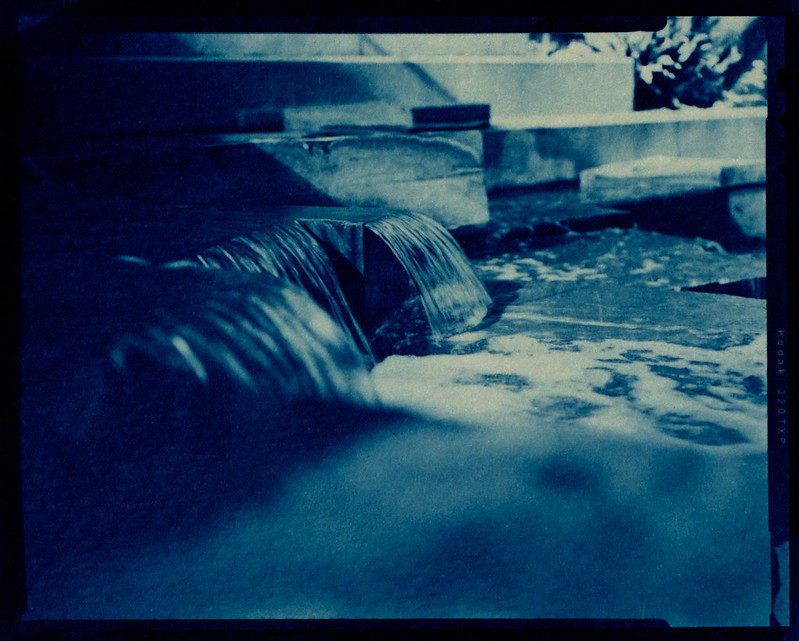I went downtown to the art supply store here in San Diego. I wanted to buy a pad of hot press watercolor paper to make some cyanotypes with. Well, either they don't make hot press in pads, or this store doesn't carry them, or both. So I ended up getting a small pad of Strathmore 400 cold press. It just says "heavy weight", but feels like 140#. One sheet (5.5x8.5 in) is just the right size for 2 4x5 negatives. So I cut it in half and coated it up with my traditional cyanotype solutions which are a year or more old, but still kicking. I left it in the dark over night to dry. The next day, I put everything in my contact printing frame and set it out for a good 7 minutes. That seemed like an adequate amount of time because I am used to using waxed paper negatives which transmit UV light much better than the plastic used in film. Needless to say, when I washed the prints (in dilute white vinegar) there was not much of an image there. The borders were dark, but the image area was very faint. I probably needed around 20 minutes. I set them aside until I could decide what to do. It was too bad I didn't have color separated negs for these photos, because this would be a great start for a tri-color gum print. But I just had the one negative for each image.
So I decided after they were dry, I would re-coat with the cyanotype solution, register the negatives over the existing image and try to print them again. This is where the miracles start happening. Usually, watercolor paper will shrink if you soak it in water then dry it. This paper didn't, at least not noticeably. In fact the negatives seemed to register perfectly over the previous image. I had to just register the edges since I couldn't really see any of the image through the negative. The next day it was completely overcast. I didn't even bother putting the printing frame outside. It was too dark by the time I got home. The next day, I knew I had to do something because the cyanotype was going to start fogging if I just left it unexposed in the printing frame. So when I saw the clouds start to clear at work, I called home and had my wonderful bride put the printing frame outside. It was still sort of cloudy, so I told her to leave it for an hour then bring it in. Then suddenly the clouds broke and the sun was out! We exchanged a couple of text messages and I figured the whole thing was a wash. There was no way to tell how much UV exposure it had, and I would just start over on the back sides of the prints. I came home and took a peek under one of the negatives and it wasn't completely dark, so I figured what the heck. I did the same vinegar wash as before and cleared it in fresh tap water. What came out was about the best cyanotypes I think I have ever made. The tonal scale is nice and long (for a cyanotype), the edges are clear, just the whole thing came out about as good as I could have wished. So through two printings of some unknowable exposure combined with sitting out for a couple of days in the air, I got a couple of beautiful prints. I can not explain how it happened, and I will never be able to reproduce the process. Anyway, here they are.
















